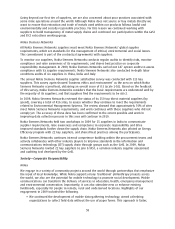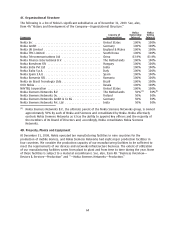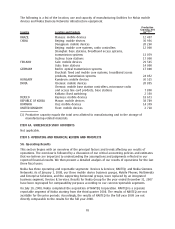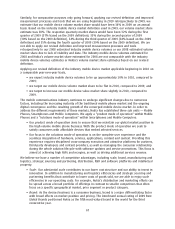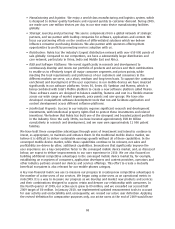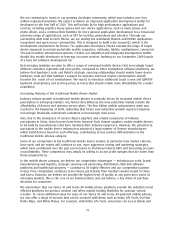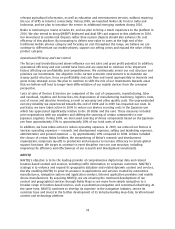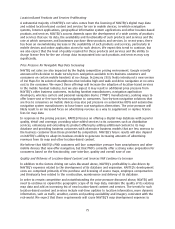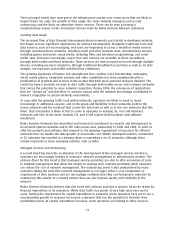Nokia 2009 Annual Report Download - page 69
Download and view the complete annual report
Please find page 69 of the 2009 Nokia annual report below. You can navigate through the pages in the report by either clicking on the pages listed below, or by using the keyword search tool below to find specific information within the annual report.Similarly, for comparative purposes only going forward, applying our revised definition and improved
measurement processes and tools that we are using beginning in 2010 retrospectively to 2009, we
estimate that our mobile device volume market share would have been 34% in 2009 on an annual
basis. Based on the industry mobile device market definition used in 2009, our volume market share
estimate was 38%. The respective quarterly market shares would have been 32% during the first
quarter of 2009 (37% based on the 2009 definition), 35% during the second quarter of 2009
(38% based on the 2009 definition), 34% during the third quarter of 2009 (38% based on the 2009
definition) and 35% during the fourth quarter of 2009 (39% based on the 2009 definition). We are
not able to apply our revised definition and improved measurement processes and tools
retrospectively to our 2008 estimated industry mobile device volumes or our 2008 estimated volume
market share due to lack of visibility and data. The industry mobile device volumes estimated for
2008 and Nokia’s volume market share estimated for 2008 are not comparable with the industry
mobile device volumes estimates or Nokia’s volume market share estimates based on our revised
definition.
Applying our revised definition of the industry mobile device market applicable beginning in 2010 on
a comparable yearoveryear basis,
• we expect industry mobile device volumes to be up approximately 10% in 2010, compared to
2009;
• we target our mobile device volume market share to be flat in 2010, compared to 2009; and
• we target to increase our mobile device value market share slightly in 2010, compared to
2009.
The mobile communications industry continues to undergo significant changes due to numerous
factors, including the increasing maturity of the traditional mobile phone market and the ongoing
digital convergence and the resulting growth of the converged mobile device market. In order to
address the different requirements of these markets, Nokia has established three sub units — Mobile
Phones, Smartphones and Mobile Computers. We apply a “product mode of operation” within Mobile
Phones and a “solutions mode of operation” within Smartphones and Mobile Computers.
• Our
product mode
of operation aims to ensure that we maintain our global market position in
the high volume mobile phone business. With the product mode of operation we seek to
satisfy consumers with affordable devices that embed selected services.
• Our focus in the
solutions mode
of operation is on the complete user experience and the
seamless integration of hardware, services, applications, content and context. Providing this
experience requires disciplined crosscompany execution and attractive platforms for partners,
thirdparty developers and content providers, as well as managing the consumer relationship
during the whole solution lifecycle with software updates and service promotions. This focus is
aimed at achieving high ASPs and margins, as well as driving additional services revenue.
We believe we have a number of competitive advantages, including scale, brand, manufacturing and
logistics, strategic sourcing and partnering, distribution, R&D and software platforms and intellectual
property.
•
Scale:
Our substantial scale contributes to our lower cost structure and our ability to invest in
innovation. In addition to manufacturing and logistics efficiencies and strategic sourcing and
partnering benefits that contribute to lower costs of goods sold, we are able to enjoy scale
efficiencies in our operating costs. For example, Nokia’s distribution and marketing efforts can
be spread across a broad portfolio of offerings in contrast to smaller competitors that often
focus on a specific geographical market, price segment or product category.
•
Brand:
As the devices business is a consumer business, brand is a major differentiating factor
with broad effects on market position and pricing. The Interbrand annual rating of 2009 Best
Global Brands positioned Nokia as the fifth mostvalued brand in the world for the third
consecutive year.
67



